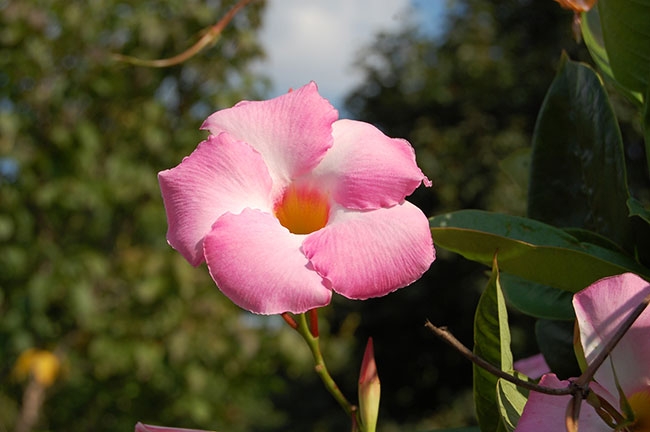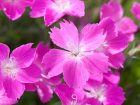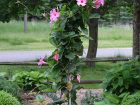
Features
Business
Trends
Growing trends in the garden for 2018/19
Plants that will be in top demand into next year – and why.
July 24, 2018 By Treena Hein
 Close-up of a mandevilla bloom. Potted tropicals are placed outdoors in the summer and brought in for the winter. photo: Mark Cullen
Close-up of a mandevilla bloom. Potted tropicals are placed outdoors in the summer and brought in for the winter. photo: Mark CullenThe Canadian gardening season is well underway and many of the planting trends now coming into flower across the nation are expected to continue into 2019. Mark Cullen, national spokesperson for lawn and garden at Home Hardware, notes that the use of eco-conscious plants – indigenous, pollinator-friendly, drought-tolerant – is really no longer a trend but here to stay. “It’s getting bigger and bigger all the time,” he says. “For the new generation of gardeners, millennials, supporting the environment is why they are gardening. That and for food.”
Denis Flanagan agrees. “The current generation of gardeners are more keyed into the big environmental factors like water scarcity,” notes the public relations and membership manager at Landscape Ontario Horticultural Trades Association. “Many municipalities have water bans every summer now, so water conservation is not something off in the future, it’s a reality now.” He believes that drought-tolerant plants are being used in landscapes more frequently
Multi-function plants which look good, are edible and offer food and shelter for pollinators will likely stay very popular for the foreseeable future. Valerie Stensson, Sheridan Nurseries’ vice-president of marketing and purchasing notes that fragrant plants that attract pollinators from Sheridan’s ‘Fragrance Garden Collection’ are selling very well.
Edibles
“The average landscape designer ten years ago might have laughed at the suggestion that an area for vegetable growing would be a major trend and an integral part of planning,” notes Flanagan. “With regards to fruit trees, ten to fifteen years ago most garden centres had stopped selling these due to lack of interest. Today we are witnessing a major revival in urban agriculture.”
Edible plants, shrubs and trees have all seen a resurgence in the past few years. Stensson notes that extremely hot varieties such as ghost peppers and scorpion peppers are very popular. “Millennials,” adds Cullen, are “definitely into herbs. Plants like sage, rosemary, mint, basil, they take up very little space and are very productive. None are really shade tolerant but do well in sunny yards, decks or south-facing balconies.”
Easy care
Demand for trees, shrubs and perennials continues to be strong as they provide years of fairly easy care – particularly native or native-based cultivars like echinacea and new hybrids. “All the hybrids nowadays are beautiful,” Cullen notes. “People are gobbling them up. And people are also getting more educated about shrubs of many sorts and seeking them out by name, such as hydrangea and black elderberry.”
Aberta Horticultural Association President Robert Spencer provides a report from their annual meeting in June on consumer interests. They mentioned that Calibrachoa (million bells) is becoming more popular as an easy-care flower instead of petunias, as they better withstand wind and do not need deadheading, which can be a time-consuming process.
Visual interest
Although Cullen does not see plants with patterned foliage (dots, dashes, stripes, swirls) as a large trend at this point, Sheridan is selling lots of these plants, from Petunia Night Sky to Brise d’Anjou Variegated Jacob’s Ladder. Flanagan notes that in addition to providing visual interest, plants with patterned foliage usually also grow very well in the shade, adding visual interest in darker corners of the flower garden.
Spencer notes that gardeners should – and are – trying out different colours. Take Ipomea (sweet potato vine) for instance, which comes in many different colours and is heat-tolerant to boot.
In terms of colours for 2018 and beyond, Home Depot identifies purple as ‘hot,’ describing it as signifying “peace, mystery, magic and ambition.” Cullen agrees that purple is popular this year, but isn’t sure whether that translates into actual sales increases. For his part, Flanagan thinks purple will stay popular into next year. “There are the permanent aspects of your garden, and then colour can be the trendy aspect,” he says. “Colour can be addressed with containers and annuals.”
Stensson reports that in addition to purple, pink and white selections are also selling well. “The latest releases in the Proven Winner Hydrangea program are all variations of white,” she notes, “and have been met with great success.” Flanagan observes that in the last two years, there have been a growing number of gardens in Ontario with only white flowers. “One of the nicest times to enjoy a garden is at night, and that’s also when people have time in their busy modern lives to do so,” he says. “The white flowers are really stunning in the evening with some strategic lighting.” Stensson adds that plants that bloom in the nighttime include Evening Primrose and Jasmine, and plants that ‘show’ well in low light with their brightly-coloured blooms include verbenas and hydrangeas.
Gardeners also continue to look upwards, using walls, fences, deck trellises and more for vines or to hang container planters on. ‘Vertical gardening’ is especially important to condo owners, says Cullen, inside and out.
Compact and portable
Flanagan notes that shrubs and perennials of many varieties, including many traditional choices like lilac and mock orange, are now available in hybridized dwarf form, and “the fear of having one shrub take over your backyard is now a thing of the past.” He adds that there are now new compact food crop varieties adapted to containers, from strawberries and rhubarb to potatoes.
Container planting shows no sign of slowing down. “Many of the new shrubs in the various branded programs are bred for compact form, which lends well to container gardening,” Stensson notes. Spencer again passes on reports from AHA annual conference presenters that gardeners are going beyond traditional containers to “all sorts of things, like desks, lamp shades, shoes and purses.” They are also making new choices for the centre of their planters, he says, replacing traditional Dracaena with plants like Coleus.
Gardeners are also putting tropical plants in containers and bringing them in every fall to overwinter inside, plants such as patchouli, lion’s tail, lemongrass, ginger, turmeric, Malabar spinach, hibiscus and oleander. “It’s very big,” says Cullen. “We’ll see more retailers carrying tropicals, especially greenhouse retailers that maintain them properly.” Tropical plants selling well at Sheridan Nurseries this year include fan palms, fiddle leaf figs, mandevilla vines and Boston ferns.
To keep up with trends, Cullen encourages greenhouse growers to have a word with every one of their retailers every year. “I travel across the country every spring for Home Hardware, and every market and every year has its own story,” he says. “I’m not sure if there’s as much asking around as there should be. Retailers might not have a lot to say but what they do say is important. You want to grow products that sell and maximize margin.”
Print this page



